
69 minute read
GUINEA E CUATORIAL GUÍA DE INVERSIÓN
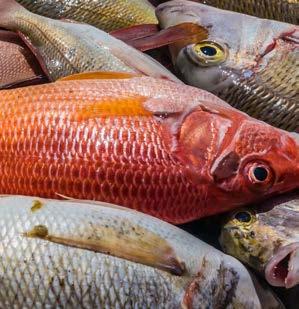
Un país repleto de oportunidades
Advertisement


P
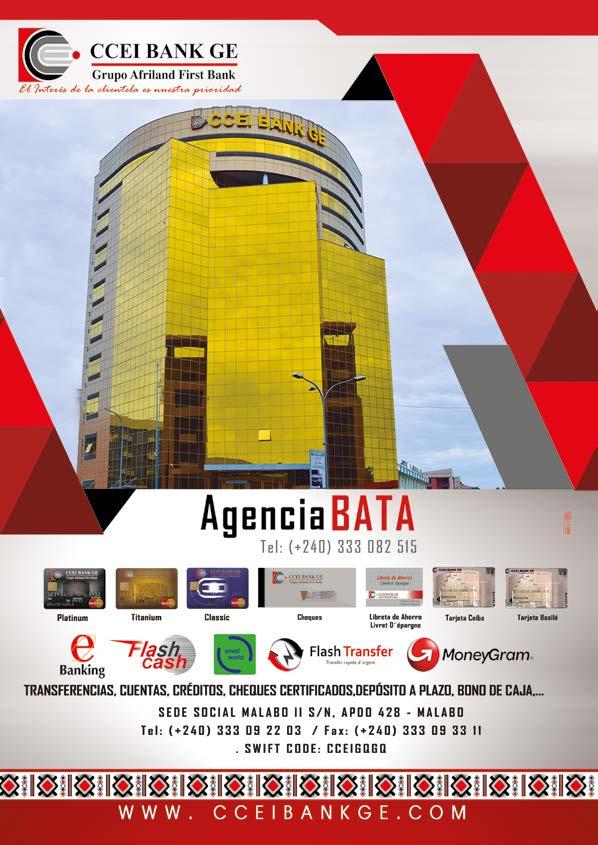
Índice/ Index
p.4 Prefacio/Foreword
p.6 Información General del País General Country Information
p.10 Demografía/Demography
p.12 Política/Politics
p.24 p.29 Recursos Humanos/Human Resources Infraestructuras/Infrasturctures
p.32 Sectores de Inversión Investment Sectors
p.44 Marco legal para la inversión en Guinea Ecuatorial Legal framework for investment in Equatorial Guinea
p.16 Economía/Economy
p.56 Información Útil para el InversorUseful Information for the Investor

Guinea Ecuatorial está inmerso en la segunda fase de Plan Nacional de Desarrollo Económico y Social. Dentro de este marco y con el objetivo de promover la diversificación económica del país, el gobierno mediante Decreto Presidencial Número 71/2014 de fecha 21 de Mayo creó HOLDING Guinea Ecuatorial, Sociedad de Inversiones y Participación de Estado. Entre las distintas funciones que realiza como brazo ejecutor de la política económica del Gobierno, HOLDING Guinea Ecuatorial Co-Invierte en proyectos rentables enfocados hacia los sectores de la agricultura, la ganadería, la pesca, la minería y los servicios en general, con el fin de eliminar la dependencia de los ingresos provenientes del sector de hidrocarburos. Para ofrecer al inversor la máxima información sobre el clima de inversión en el país, HOLDING Guinea Ecuatorial ha realizado esta Guía de Inversión actualizada en octubre de 2018.
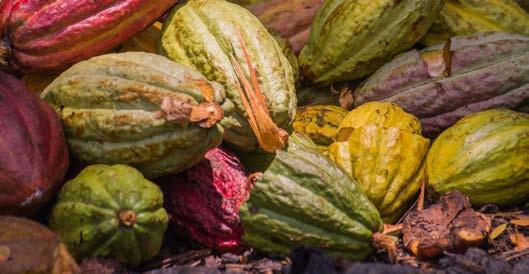

Equatorial Guinea is immersed in the second phase of the National economic and social development plan. Within this framework and with the objective of promoting the country’s economic diversification, the government through Presidential Decree number 71/2014 dated 21st May, created HOLDING Equatorial Guinea, an investment and State participation society. Among its various functions as an executing arm of the Government’s economic policy, HOLDING Equatorial Guinea Co-invests in profitable projects focused on agriculture, livestock, fisheries, mining and services in general, with a view to eliminate dependence on revenues from the hydrocarbon sector. In order to offer investors the maximum information on the investment climate in the country, HOLDING Equatorial Guinea has made this investment guide updated in October 2018.


Nombre oficial: República de Guinea Ecuatorial.
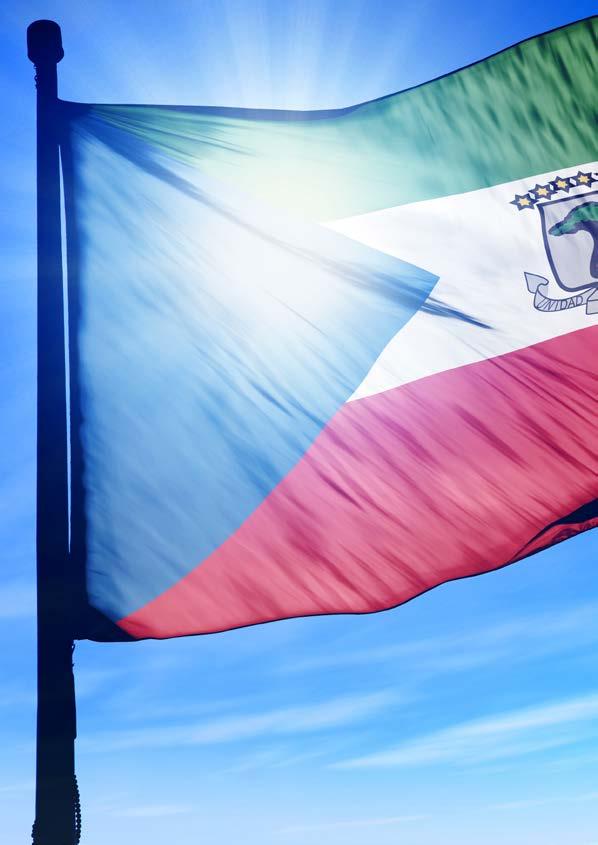
Localización: está situado en el hemisferio norte al centro-oeste de África. Limita al norte con Camerún y al sur y este con Gabón.
Clima: Guinea Ecuatorial tiene un clima tropical. La temperatura media anual es de 25˚C, aunque puede llegar a ser en torno a 10˚C más baja en los puntos más altos. En la isla de Bioko la estación lluviosa comprende el período de abril a octubre, mientras que en el continente, las lluvias son un poco más ligeras y tienen lugar de abril a mayo y de octubre a diciembre.
Recursos naturales: petróleo, madera, cacao, pesca.
Official name: Republic of Equatorial Guinea.

Location: Northern hemisphere to west-central Africa. It limits to the north with Cameroon and to the south and east with Gabon.
Climate: Equatorial Guinea has a tropical climate. The average annual temperature is 25°C, although it can be around 10°C lower at the highest points. On the island of Bioko the rainy season covers the period from April to October, while on the mainland the rains are a bit lighter and take place from April to May and from October to December.
Natural resources: oil, wood, cocoa, fishing.

Sistema Político: República semi-presidencialista. La reforma de la constitución aprobada en el 2011 por referéndum, limitó el mandato presidencial a 2 periodos de 7 años, instauró el puesto de vicepresidente y la cámara del senado, además de las nuevas instituciones gubernamentales como el Tribunal de Cuentas y la Oficina del Defensor del Pueblo.
Jefe de Estado: S.E. Teodoro Obiang Nguema Mbasogo.
Jefe de Gobierno: S.E. Francisco Pascual Obama Asué.
Población: 1.222.442 (2015).
Lenguas Oficiales: la primera lengua oficial es el español utilizada en la enseñanza y la administración. La segunda lengua oficial es el francés y la tercera el portugués.
Otras lenguas: existen diferentes lenguas autóctonas pertenecientes a las diversas etnias de Guinea Ecuatorial. Estas son el fang, el bubi, el ndowe, el bisio y las lenguas criollas o pidgin; entre las que se encuentra el pidgin crio (pichinglis), tercera lengua más hablada por detrás del español y el fang, y el criollo annobonés.
Religión: la religión mayoritaria es el catolicismo. Se practican otras religiones como el protestantismo o el islam.
Moneda: Franco CFA de África Central (XAF). Tipo de cambio: 579,1 XAF por 1 USD, 655,957 XAF por 1€
Peso y Medidas: sistema métrico decimal.
Capital: Malabo, Bioko Norte.
Provincias: se divide en 7 provincias: Bioko Norte, Bioko Sur, Litoral, Centro Sur, Kie-Ntem, Wele-Nzas, Annobón. El 1 de agosto de 2015, cuando se inauguró la nueva ciudad administrativa de Djibloho, se proclamó que Djibloho será la octava provincia del país.
Capitales de Provincias: Luba, Bata, Evinayong, Ebebiyin, Mongomo, San Antonio de Palé, Djibloho.
Ciudades de interés para el Inversor: Mbini (Ciudad Industrial).
Zona horaria: GMT +1 (No aplicable horario de verano).
Prefijo telefónico: +240
Superficie: 28.052 Km².
Punto más alto: Pico Basilé.
HORARIOS DE OFICINA Administración Pública - Lunes a viernes de 8:00 a 16:00. Sector Privado - Lunes a sábado de 8:00 a 13:00 y de 16:00 a 19:00. Bancos - Lunes a sábado de 8:00 a 14:00.


Political System: Semi-presidential Republic. The constitution reform approved in 2011 by referendum, limited the presidential mandate to 2 periods of 7 years; established the vice-president post and the chamber of the senate in addition to new governmental institutions such as the Court of Auditors and the Ombudsman Office.
Head of State: H.E. Teodoro Obiang Nguema Mbasogo.
Head of Government: H.E. Francisco Pascual Obama Asué.
Population: 1,222,442 (2015).
Official Languages: Spanish is the first official language, used in teaching and administration. The second official language is French and the third is Portuguese.
Other languages: there are different native languages belonging to the different ethnic groups of Equatorial Guinea. These are fang, bubi, ndowe, bisio and creole or pidgin languages; among which is the pidgin crio (pichinglis), the third most spoken language behind the Spanish and the Fang, and the Creole annobonés.
Religion: Catholicism is the predominant religion. Other religions such as Protestantism or Islam are practiced.
Currency: Central African CFA Franc (XAF). Exchange rate: 579.1 XAF for 1 USD, XAF 655.957 for 1 €
Weight and Measures: metric system.
Capital: Malabo, Bioko Norte.
Provinces: divided in 7 provinces: Bioko North, South Bioko, Coastal, South Center, Kie-Ntem, Wele-Nzas, Annobón. On 1st August 2015 when the new administrative city of Djibloho was inaugurated, it was proclaimed that Djibloho will be the eighth province of the country.
Capitals of Provinces: Luba, Bata, Evinayong, Ebebiyin, Mongomo, San Antonio de Palé, Djibloho.
Cities of interest to the investor: Mbini (Industrial City).
Time Zone: GMT +1 (Not applicable for daylight saving time).
Telephone code: +240
Surface area: 28.052 Km².
Highest point: Pico Basilé.
OFFICE HOURS Public Administration - Monday to Friday from 8:00 a.m. to 4:00 p.m. Private Sector - Monday to Saturday from 8:00 a.m. to 1:00 p.m. and from 4:00 p.m. to 7:00 p.m. Banks - Monday to Saturday from 8:00 a.m. to 2:00 p.m.
Cuadro de población por provincias (2015)*
La población se estimó en 1.307.487 habitantes en 2017 según el Instituto Nacional de Estadística de Guinea Ecuatorial (INEGE), siendo la ciudad más poblada Bata. Se ha experimentado un crecimiento de la población del 3,42%. Las lenguas vernáculas son el fang, bubi, ndowe, bisio y annobonés. En la capital también es frecuente el uso del dialecto pidgin. La esperanza de vida al nacer es de 59,3 años para los hombres y 59,5 años para las mujeres.
provincia total hombres mujeres
BIOKO NORTE 299.836 162.211 137.625
BIOKO SUR 34.627 17.625 17.002
LITORAL 366.130 202.103 164.027
WELE NZAS 191.383 104.304 87.079
CENTRO SUR 141.903 71.803 70.100
KIE NTEM 183.331 91.116 92.215
ANNOBON 141.903 71.803 70.100
TOTAL 1.222.442 651.820 570.622
Pirámide de Población *FUENTE: INEGE (Instituto Nacional de Estadística de Guinea Ecuatorial). En base a la población de 1.222.442 estimada en 2015.
La pirámide de población de Guinea Ecuatorial presenta características de una estructura joven.
Guinea Ecuatorial 2009 Hombre Mujer
100+ 95 - 99 90 - 94 85 - 89 80 - 84 75 - 79 70 - 74 65 - 69 60 - 64 55 - 59 50 - 54 45 - 49 40 - 44 35 - 39 30 - 34 25 - 29 20 - 24 15 - 19 10 - 14 5 - 9 0 - 4
* FUENTE: PRODEGE 2011 - Panorama of education in Equatorial Guinea. Progress and educational quality challenges to 2010. Población (en miles)
Geografía
Es uno de los países más pequeños del continente africano, abarca una superficie de 28.051 km² en pleno África Central. Su parte continental también conocida como Río Muni limita con Camerún al norte, Gabón al sur y al este y el Golfo de Guinea al oeste. Su área insular comprende las islas de Bioko, Annobón, Corisco, Elobey Grande y Elobey Chico situadas en el Golfo de Guinea. Administrativamente, Guinea Ecuatorial se divide en 7 provincias, que a su vez se dividen en distritos y municipios.
Population by provinces (2015)*
province total men females
NORTH BIOKO BIOKO SOUTH 299.836 162.211 137.625
34.627 17.625 17.002
LITORAL 366.130 202.103 164.027
WELE NZAS 191.383 104.304 87.079
CENTRO SUR 141.903 71.803 70.100
KIE NTEM 183.331 91.116 92.215
ANNOBON 141.903 71.803 70.100 The population was estimated at 1,307,487 inhabitants in 2017 according to the National Institute of Statistics of Equatorial Guinea (INEGE), being the city Bata, the most populated. A population growth of 3.42% has been experienced. The vernacular languages are fang, bubi, ndowe, bisio and annobonés. In the capital is also frequent the use of pidgin dialect. Life expectancy at birth is 59.3 years for men and 59.5 years for women.
TOTAL 1.222.442 651.820 570.622
Population Pyramid * SOURCE: INEGE (National Statistics Institute of Equatorial Guinea). Based on the population of 1,222,442 estimated in 2015.
Equatorial Guinea population pyramid presents characteristics of a young structure.
Equatorial Guinea 2009 Male Female
100+ 95 - 99 90 - 94 85 - 89 80 - 84 75 - 79 70 - 74 65 - 69 60 - 64 55 - 59 50 - 54 45 - 49 40 - 44 35 - 39 30 - 34 25 - 29 20 - 24 15 - 19 10 - 14 5 - 9 0 - 4
* SOURCE: PRODEGE 2011 - Panorama of education in Equatorial Guinea. Progress and educational quality challenges to 2010. Population (in thousands)
Geography
It is one of the smallest countries of the African continent, covers an area of 28.051 km² in Central Africa. Its mainland also known as Muni River, borders Cameroon to the north, Gabon to the south east, and the Gulf of Guinea to the west. Its insular area includes the islands of Bioko, Annobon, Corisco, Elobey Grande and Elobey Chico located in the Gulf of Guinea. Administratively, Equatorial Guinea is divided into 7 provinces, which in turn are divided into districts and municipalities.
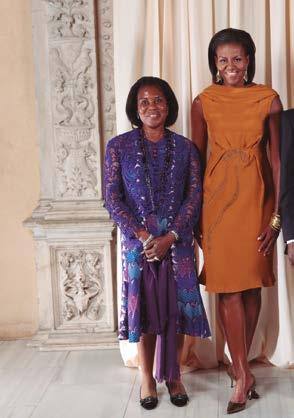

DESDE SU INDEPENDENCIA EN 1968, GUINEA ECUATORIAL HA SIDO UNA REPÚBLICA DEMOCRÁTICA INSTITUCIONAL. EL SISTEMA POLÍTICO ES MULTIPARTIDISTA, EN LA ACTUALIDAD EXISTEN 18 PARTIDOS POLÍTICOS LEGALIZADOS EN EL PAÍS. G uinea Ecuatorial tiene un parlamento bicameral compuesto por la cámara de los representantes del pueblo integrado por 100 miembros y la cámara del senado de reciente creación integrado por 60 miembros. Los senadores y diputados son elegidos por un mandato de 5 años mediante sufragio universal. El presidente es elegido por el pueblo para ejercer como jefe de Estado y jefe de Gobierno por un mandato de 7 años. El primer ministro es nombrado por el presidente para ejercer la función ejecutiva administrativa.
SINCE INDEPENDENCE IN 1968, EQUATORIAL GUINEA HAS BEEN AN INSTITUTIONAL DEMOCRATIC REPUBLIC. THE POLITICAL SYSTEM IS MULTI-PARTY, THERE ARE CURRENTLY 18 LEGALIZED POLITICAL PARTIES IN THE COUNTRY. E quatorial Guinea has a bicameral parliament composed of the House of People Representatives integrated by 100 members and the newly created Senate House integrated by 60 members. Senators and Representatives are elected by universal suffrage, for a five years term. The president is elected by the people to serve as Head of State and Head of Government for a term of 7 years. The Prime Minister is appointed by the President to exercise the Executive Administrative Function.


In November 2011 by popular referendum, a Constitutional Reform was approved with 97,7 percentages of the votes. This reform limits presidential mandates to two consecutive periods


En Noviembre de 2011 se aprobó mediante referéndum popular, con un porcentaje del 97,7 de los votos, una reforma constitucional. Esta reforma limita los mandatos presidenciales a dos periodos consecutivos, no pudiendo presentarse a un tercero hasta que se produzca alternancia. Esta reforma también instauró la figura del vicepresidente del Gobierno y las instituciones del Senado, el Consejo de la República, el Consejo Nacional para el Desarrollo Económico y Social, el Tribunal de Cuentas y el Defensor del Pueblo.
Tras las elecciones presidenciales celebradas en abril de 2016, con una victoria por mayoría absoluta del Partido Democrático de Guinea Ecuatorial (PDGE), se formó un nuevo gobierno.
Históricamente el índice de criminalidad en Guinea Ecuatorial es bajo, lo que le convierte en uno de los países con mayor seguridad personal y de la propiedad en la subregión de África Central. In November 2011 by popular referendum, a Constitutional Reform was approved with 97,7 percentages of the votes. This reform limits presidential mandates to two consecutive periods and cannot be submitted to a third party until alternation occurs. This reform also included the figure of the Vice-President of the Government and the Senate, the Council of the Republic, the National Council for Economic and Social Development, the Court of Auditors and the Ombudsman institutions.
After the Presidential elections held in April 2016, with a victory by an absolute majority of the Equatorial Guinea Democratic Party (PDGE), a new government was formed.
Historically, the crime rate in Equatorial Guinea has been low, making it one of the countries with the greatest personal and property security in the Central African sub-region.

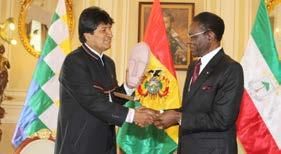
EY in Africa

6.000 Employees
33 Offices
EY has been in Equatorial Guinea for more than 17 years. The insights and quality services we deliver help build trust and confidence to improve business practices and to attract new investors in Equatorial Guinea.
We develop outstanding leaders who team up to deliver our promises to all our stakeholders. In doing so, we play a critical role in building a better working world for our people, for our clients and for our communities.
The strength of an integrated Network to serve our clients
EY office in Equatorial Guinea has 20 people integrated into a network of more than 212,000 professionals worldwide and rely on 14 sectorial centers of excellence.
Contact: EY Equatorial Guinea Malabo II. 6th floor. Abayak building PO Box: 752. Malabo – Equatorial Guinea Phone: (+240) 333 09 67 19 / 333 09 16 86 Fax: (+240) 333 09 46 59 Mail: alexis.moutome@gq.ey.com
About EY EY is a global leader in assurance, tax, transaction and advisory services. The insights and quality services delivered by our teams help to build trust and security in the economy and financial markets all over the world. We develop outstanding leaders who team to deliver on our promises to all of our stakeholders. In so doing, we play a critical role in building a better working world for our people, our clients and our communities.
EY refers to the global organization as well as to the different member firms of Ernst & Young Global Limited, which are separated legal entities. Ernst & Young Global Limited is a limited liability company from the UK which does not provide services to its clients. For more information about our organization, please visit ey.com.
LA ECONOMÍA DE GUINEA ECUATORIAL HA CRECIDO ESPECTACULARMENTE DURANTE LAS ÚLTIMAS DOS DÉCADAS. EN LA ACTUALIDAD SE SIGUE TRABAJANDO PARA QUE PUEDA CONVERTIRSE EN UNA ECONOMÍA AFRICANA LÍDER EN 2020.
Este crecimiento se ve reflejado en su PIB. Mientras que en 1992 su PIB alcanzó los 154 millones dólares USD, en 2012 alcanzó los 21,5 miles de millones USD reflejando una de las tasas de crecimiento más fuertes registradas en el mundo.
El impulsor de este crecimiento económico fue el descubrimiento y explotación de yacimientos petrolíferos conllevando paralelamente al desarrollo político, económico y de infraestructuras allanando el camino a la diversificación económica y el crecimiento continuo, objetivos principales del Plan Nacional de Desarrollo Económico y Social (Horizonte 2020).
Guinea Ecuatorial entro en recesión en 2013 con un crecimiento de PIB de -4,1% (tras obtener un crecimiento de +8,3% en 2012) debido a las ligeras disminuciones en la producción de petróleo y a la caída del precio del petróleo. El desarrollo infraestructural y el comercio permiten que se continúe hacia la diversificación de su economía. Se estima que el PIB del 2017 alcanzó los 13 mil millones de USD.
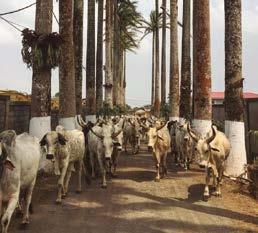
La producción de petróleo y gas es el sector más importante de Guinea Ecuatorial. El Golfo de Guinea produce más o menos el 5% del petróleo a nivel mundial, es el mayor proveedor en la región de la CEMAC y el tercer mayor proveedor de África. En Mayo de 2017 Guinea Ecuatorial entró en la Organización de Países Exportadores de Petróleo (OPEP) como su socio número catorce. El sector del petróleo y el gas actualmente contribuyen casi al 90% del PIB. La adopción de políticas de apertura comercial han permitido a la economía guineana elevarse a los mercados internacionales del petróleo beneficiando tanto a los ciudadanos como a los socios comerciales.
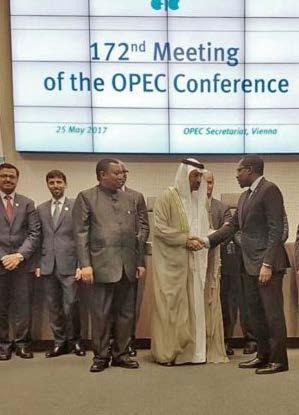
Las infraestructuras son un valioso contribuyente a la economía de Guinea Ecuatorial. La pesca, la agricultura y la ganadería también son valiosos componentes de la economía de Guinea Ecuatorial. La agricultura representa el 1,1% del PIB mientras que el aporte de la pesca al PIB todavía es muy bajo, en la actualidad se produce 170.000 kilogramos de diversos pescados y productos marinos en los puertos nacionales.
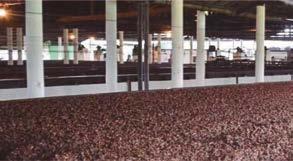
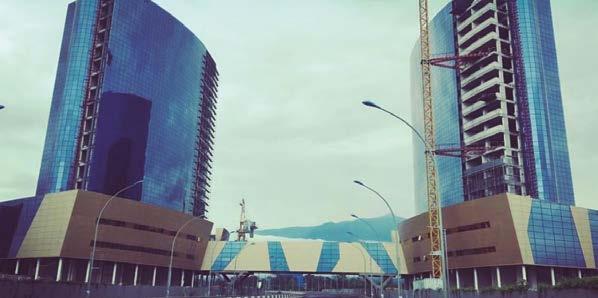
EQUATORIAL GUINEA’S ECONOMY HAS GROWN DRAMATICALLY OVER THE PAST TWO DECADES. CURRENTLY FURTHER WORK IS UNDER WAY TO MAKE IT A LEADING AFRICAN ECONOMY BY 2020.
This growth is reflected in its GDP. While in 1992 its GDP reached USD 154 million, in 2012 it reached USD 21,5 billions, reflecting one of the strongest growth rates in the world.
The driving force behind this economic growth was the discovery and exploitation of oil fields, along with political, economic and infrastructure development, paving the way for economic diversification and continuous growth, the main objectives of the National Economic and Social Development Plan (Horizon 2020).
Equatorial Guinea went into recession in 2013 with GDP growth of -4.1% (after gaining + 8.3% growth in 2012) due to slight declines in oil production and falling oil prices. Infrastructure development and trade allow the economy to continue to diversify its economy. It is estimated that the 2017 GDP reached USD 13 billions.


Oil and gas production is the most important sector of Equatorial Guinea. The Gulf of Guinea produces more or less 5% of the world’s oil, is the largest supplier in the CEMAC region and the third largest supplier in Africa. In May 2017 Equatorial Guinea entered the Organization of the Petroleum Exporting Countries (OPEC) as its partner number fourteen. The oil and gas sector currently contributes almost 90% of the GDP. The adoption of trade liberalisation policies has enabled the Guinean economy to rise to international oil markets, benefiting both citizens and trade partners.
Infrastructure is a valuable contributor to the economy of Equatorial Guinea. Fisheries, Agriculture and Livestock are also valuable components of the economy of Equatorial Guinea.
Agriculture accounts for 1.1% of GDP while the contribution of fishing to GDP is still very low, currently producing 170,000 kilograms of various fish and marine products in national ports.

Los hidrocarburos, principalmente el petróleo, han sido mejor piloto del comercio y la inversión en Guinea Ecuatorial. El petróleo con una producción que contribuye al 89% del PIB, es el mayor producto de exportación de Guinea Ecuatorial. La producción del petróleo creció en la década de 1990 hasta 2012, cuando por primera vez comenzó a disminuir. Las exportaciones de crudo crecieron de 4,7 millones de francos en 1992 a 1,3 billones de CFA en 2002 y 5,6 billones de CFA en 2012. Existen probadas reservas de petróleo equivalentes a 1,2 billones de barriles, reservas suficientes para soportar diez años de producción continua al ritmo actual. Junto con el petróleo, el metanol y otros gases convertidos son las mayores exportaciones de Guinea Ecuatorial. En 2002 los ingresos de exportación de metanol y otros gases fueron de 63 millones de FCFA, cifra que aumentó hasta 3,1 billones de FCFA en 2012. Al igual que con el crudo, se espera que las exportaciones de gas disminuyan moderadamente en el futuro.
Las estimaciones del 2016 sitúan la tasa de inversiones en un 10,9% y el grado de apertura al exterior en un 47,2%.
La tasa de inflación (IPC) en 2016 se sitúo en 1,4% experimentando una bajada frente al 1,7% alcanzado en el año 2015. La tendencia a la baja sigue siendo visible tras el análisis del primer trimestre de 2017, el IPC en este período se sitúo en 1,1% frente al 2,3% alcanzado en el mismo período de 2016.
Comercio
Guinea Ecuatorial tiene un activo comercio liberal y régimen de inversión. Con el desarrollo de la industria del petróleo en la década de 1990, el gobierno implementó políticas para un programa de inversión pública, levantó restricciones a las importaciones y eliminó muchos requerimientos de las licencias de comercio. Dentro del Plan Nacional de Desarrollo Económico y Social se busca promover y materializar las oportunidades de comercio exterior.

La economía de Guinea Ecuatorial es altamente dependiente del comercio y la inversión. Las exportaciones como porcentaje del PIB en los últimos 10 años han oscilado entre el 82% en 2007 y el 96% en 2008. Se estima que en 2016 el valor de las exportaciones alcanzaron los 6,4 miles de millones USD.
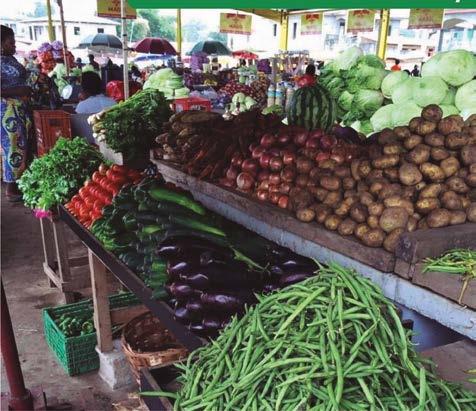
The inflation rate (CPI) in 2016 stood at 1.4%, down from 1.7% in 2015. The downward trend continues to be visible after the analysis of the first quarter of 2017, the CPI in this period stood at 1.1% compared to 2.3% in the same period of 2016.
Trade
Equatorial Guinea has an active liberal trade and investment regime. With the development of the oil industry in the 1990s, the government implemented policies for a public investment program, lifted restrictions on imports and eliminated many requirements for trade licenses. Within the National Plan for Economic and Social Development it aims to promote and materialize foreign trade opportunities.
The economy of Equatorial Guinea is highly dependent on trade and investment. Exports as a percentage of GDP in the last 10 years have ranged from 82% in 2007 to 96% in 2008. It is estimated that in 2016 the value of exports reached USD 6,4 billions. Hydrocarbons, mainly oil, have been a better driver of trade and investment in Equatorial Guinea. Oil with a production that contributes to 89% of GDP, is the largest export product of Equatorial Guinea. Oil production grew in the 1990s until 2012, when it first began to decline. Crude exports grew from 4.7 million francs in 1992 to 1.3 billion CFA in 2002 and 5.6 billion CFA in 2012. There are proven oil reserves equivalent to 1.2 trillion barrels, sufficient reserves to bear ten years of continuous production at the current pace. Together with oil, methanol and other converted gases are the largest exports of Equatorial Guinea. In 2002 export revenues for methanol and other gases were 63 million CFAF, which increased to CFAF 3.1 billion in 2012. As with crude, gas exports are expected to decline moderately in the future.
The estimates for 2016 place the investment rate at 10.9% and the degree of openness abroad at 47.2%.
Servicios financieros
El BEAC (Banco de los Estados del África Central) es el banco central de los países miembros de la CEMAC, entre los que se encuentran Guinea Ecuatorial, Gabón, Camerún, Congo, República Centroafricana y Chad. Todas las actividades de banca comercial están reguladas por la Comisión Bancaria del África Central (COBAC), una institución dentro de la CEMAC que sitúa el ratio de créditos dudosos en menos del 5%.
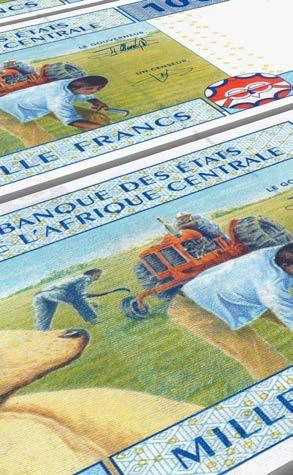
El número de bancos que operan en el país llegó a 5 en 2011, formando un sistema financiero estable. Estos incluyen a BANGE con 14 sucursales, seguido de CCEI BANK con 9, BGFI Bank con 8, SGBGE con 7 y ECOBANK con 3 sucursales.
Los servicios financieros disponibles incluyen ahorros y cuentas corrientes, préstamos a corto plazo, las transacciones de cambio de divisas, servicios de transferencia de dinero (nacional e internacional) tarjetas de crédito y débito, inversiones de capital y garantías.
El régimen de regulación de seguros fue revisado recientemente. El número total de compañías de seguros que operan en el país es de tres: EGICO, CHANAS ASSURANCES y AFRICAINE DES ASSURANCES, así como tres corredurías de seguros entre las que se encuentra ASCOMA, MOBI GUINEA y GUINEA BROKERS.
Financial services
The Bank of Central African States (BEAC) is the central bank of the CEMAC member countries, including Equatorial Guinea, Gabon, Cameroon, Congo, Central African Republic and Chad. All commercial banking activities are regulated by the Central African Banking Commission (COBAC), an institution within the CEMAC that places the doubtful loan ratio at less than 5%.
The number of banks operating in the country reached 5 in 2011, forming a stable financial system. These include BANGE with 14 branches, followed by CCEI BANK with 9, BGFI Bank with 8, SGBGE with 7 and ECOBANK with 3 branches.
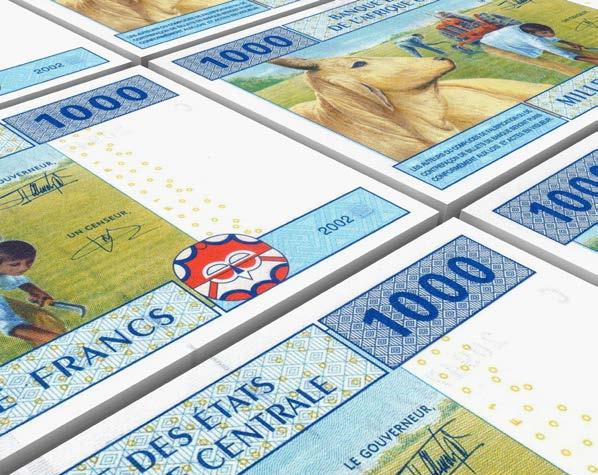
Available financial services include savings and current accounts, short-term loans, currency exchange transactions, money transfer services (national and international), credit and debit cards, equity investments and guarantees.
The insurance regulatory regime was recently revised. The total number of insurance companies operating in the country is three: EGICO, CHANAS ASSURANCES and AFRICAINE DES ASSURANCES, as well as three insurance brokerages including ASCOMA, MOBI GUINEA and GUINEA BROKERS.

Taxes
Law No 4/2004 REGULATORY OF THE EQUATORIAL GUINEA TAX SYSTEM delimits the country’s fiscal system. The tax system is influenced by Spanish legislation as well as the agreements and directives of the CEMAC. Its operation is similar to that of the existing EU regulatory directives for the main taxes, as well as the agreement to avoid double taxation in the Member States (Fiscal Convention 1966). The directives are developed by member countries as part of their internal legislation. The Ministry of Finance and Budget General Directorate of Taxes and Contributions is responsible for the design and analysis of fiscal policy as well as the implementation of harmonised and non-harmonised CEMAC standards. It is structured in different management bodies in Malabo and Bata.
Impuestos
La ley 4/2004 REGULADORA DEL SISTEMA TRIBUTARIO DE GUINEA ECUATORIAL delimita el sistema fiscal del país. El sistema tributario está influenciado por la legislación española, así como de los acuerdos y directivas de la CEMAC. Su funcionamiento es similar al de las directivas reguladoras existentes en la Unión Europea para los principales impuestos, así como el acuerdo para evitar la doble imposición en los Estados miembros (Convención fiscal 1966). Las directivas son desarrolladas por los países miembros como parte de su legislación interna. La Dirección General de Impuestos y Contribuciones del Ministerio de Hacienda y Presupuestos se encarga del diseño y el análisis de la política fiscal, así como de la implementación de las normas CEMAC armonizadas y no armonizadas. Se estructura en diferentes órganos de gestión en Malabo y Bata.
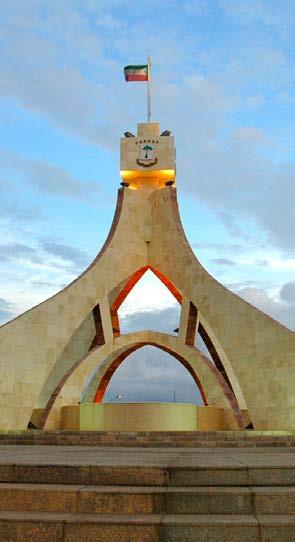
Guinea Ecuatorial Descubre y su amplia oferta hotelera
Hotel Sofitel Sipopo Le Golf MALABO
Hotel Sofitel Presidence Palace MALABO Hotel Hilton MALABO
Hotel 3 de Agosto MALABO
Hotel Ibis MALABO-BATA
Hotel Federaciones MALABO-BATA
Hotel Hospital La Paz MALABO-BATA

Kogo Ocean Resort KOGO
Hotel Corisco CORISCO Hotel Moka MOKA
Grand Hotel Djibloho DJIBLOHO
Carreteras
Guinea Ecuatorial posee una moderna red de carreteras pavimentadas en su totalidad. Esta red es el resultado de la rehabilitación de las carreteras existentes y de la construcción de 2 autopistas una en Bioko y otra la región continental. Además de reducir el tiempo de trayecto entre distintas ciudades, la autopista de la región continental conecta con Camerún y Gabón.
Puertos
Malabo Tiene un muelle de más de 480 lineales y 400 metros de rompeolas. Dispone también de 60.000 metros cuadrados para el depósito de contenedores comerciales. Con una profundidad de 16 metros, permite atracar a buques de gran calado (Panamax y Neopanamax). Cuenta con un puerto adicional en seco, KM 5, para el almacenamiento de los contenedores que llegan a la isla de Bioko.
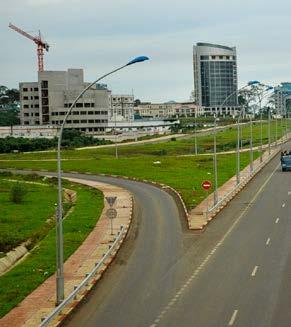
Luba El puerto cuenta con una zona franca de 100 hectáreas. Luba Freeport está especializado en la logística y aprovisionamiento de barcos petrolíferos.
Bata Tiene un muelle de 310 metros de longitud con 4 puntos de atraque. El calado de la parte interior es de 11 metros y en la exterior es de 11,30 metros.
Tanto el puerto de Malabo como el de Bata siguen en proceso de ampliación ya que suponen una pieza clave dentro de la estrategia del Gobierno para convertir al país en un centro logístico dentro del Golfo de Guinea. Otros puertos en Guinea Ecuatorial se encuentran en Cogo, Corisco y Annobón.
Aeropuertos
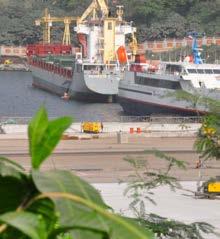
Las infraestructuras aeroportuarias fueron renovadas recientemente como consecuencia de la primera fase del Plan Nacional de Desarrollo. El país cuenta con 5 aeropuertos en Malabo, Bata, Annobón, Mongomeyen y Corisco. Próximamente se finalizará la construcción de una nueva terminal internacional en el aeropuerto de Malabo.
Roads
Equatorial Guinea has a modern network of paved roads in its entirety. This network is the result of the rehabilitation of the existing highways and the construction of two motorways one in Bioko and another the continental region. In addition to reducing travel time between different cities, the mainland highway connects with Cameroon and Gabon.
Ports

Malabo It has a pier of more than 480 linear and 400 meters of breakwaters. It also has 60,000 square meters for the commercial container depot. With a depth of 16 meters, it allows docking of vessels of great draft (Panamax and Neopanamax). It has an additional dry port, KM 5, for the storage of the containers that arrive to the island of Bioko.
Luba The port has a free zone of 100 hectares. Luba Freeport specializes in the logistics and supply of oil ships.
Bata It has a dock of 310 meters in length with 4 berth points. The draft of the inner part is 11 meters and the outside is 11.30 meters.
Both the port of Malabo and Bata are still in the process of expansion as they are a key part of the Government’s strategy to turn the country into a logistics center within the Gulf of Guinea. Other ports in Equatorial Guinea are in Cogo, Corisco and Annobón.
Airports

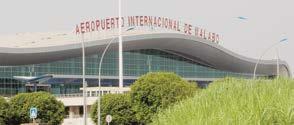
Airport infrastructures were recently renewed as a result of the first phase of the National Development Plan. The country has 5 airports in Malabo, Bata, Annobon, Mongomeyen and Corisco. The construction of a new international terminal will soon be completed at the Malabo airport.
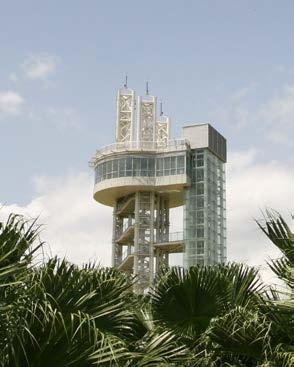
Telecomunicaciones
En la actualidad existen tres operadores de líneas móviles Getesa Orange, Muni y Gecomsa. La operadora principal de telefonía fija es Getesa Orange. Entre los proveedores de servicios de internet se encuentran las empresas Getesa Orange, Muni, Gecomsa, IPX, Guineanet y Fénix. Guinea Ecuatorial se unió en 2012 a las redes mundiales de alta velocidad de internet con el cable submarino de fibra óptica ACE (African Coast to Europe), a través del Gestor de Infraestructuras de Telecomunicaciones de Guinea Ecuatorial (GITGE) las telecomunicaciones están experimentando una gran mejora del servicio.
Líneas áereas
En el país operan 4 aerolíneas ecuatoguineanas Cronos, Punto Azul, Air Annobón y Ceiba Intercontinental que proporcionan vuelos nacionales e internacionales a distintas ciudades de África. Ceiba Internacional, la compañía aérea nacional, enlaza Malabo con más de 10 destinos internacionales como Madrid, Duala, Libreville, Lomé, Santo Tomé, Pointe Noire, Brazzaville, Cotonou, Abiyán y Acra.

Las compañías aéreas internacionales Air France, Iberia, Lufthansa, Ethiopean Airlines y Royal Air Maroc operan vuelos que conectan a la capital Malabo con ciudades como París, Madrid, Frankfurt, Adís Abeba y Casablanca.
Servicios de envios de mercancia
Air France, Lufthansa, Ethiopean Airlines y DHL ofrecen servicios de carga aérea. Los servicios de carga marítima los comercializan empresas como Besora, Mac Guinea y Maresa, esta última también ofrece servicios de carga aérea.
Airlines
4 Equatorial Guinean airlines operate in the country Cronos, Punto Azul, Air Annobón and Ceiba Intercontinental that provide national and international flights to different cities in Africa. Ceiba International, the national carrier, links Malabo with more than 10 international destinations such as Madrid, Douala, Libreville, Lomé, Sao Tome, Pointe Noire, Brazzaville, Cotonou, Abidjan and Accra.International airlines Air France, Iberia, Lufthansa, Ethiopean Airlines and Royal Air Maroc operate flights connecting the capital Malabo with cities such as Paris, Madrid, Frankfurt, Addis Ababa and Casablanca.
Goods shipping services
Air France, Lufthansa, Ethiopean Airlines and DHL offer air cargo services. Sea freight services are marketed by companies such as Besora, Mac Guinea and Maresa, the latter also offers air freight services.
Telecomunications
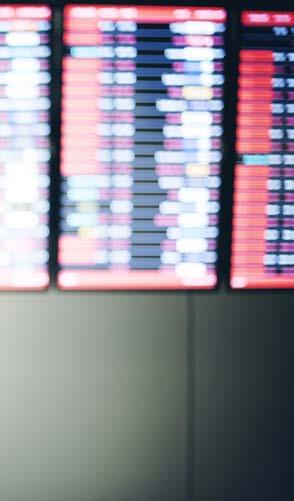
At present there are three mobile line operators Getesa Orange, Muni and Gecomsa. The main operator of fixed telephony is Getesa Orange. Internet service providers include Getesa Orange, Muni, Gecomsa, IPX, Guineanet and Fénix. In 2012, Equatorial Guinea joined the global high-speed internet networks with the submarine fiber optic cable ACE (African Coast to Europe), through the Telecommunications Infrastructure Manager of Equatorial Guinea (GITGE), telecommunications are experiencing great service improvement.

Pceiba
La Ley 10/2012 de fecha 24 de Diciembre sobre la reforma general del trabajo, regula el mercado de trabajo y los derechos de los trabajadores, promueve el empleo, formación y capacitación de la mano de obra nacional. Además, la ley laboral de Guinea Ecuatorial ratifica los convenios y tratados internacionales en materia de no discriminación, abolición del trabajo forzado e infantil. La recién creada Oficina Nacional de Empleo (O.N.E) se encarga de publicar ofertas de empleo conectando a empleadores y trabajadores mediante la bolsa de empleo. También es posible encontrar trabajadores cualificados mediante agencias de trabajo temporal.
Trabajadores nacionales y expatriados
La Ley número 6/1992 de fecha 3 de Enero, Reguladora de la Política Nacional de Empleo establece que las empresas o empleadores pueden contratar mano de obra extranjera cualificada de no existir ésta en la mano de obra nacional. El número de trabajadores extranjeros no podrá ser superior al 10% de la plantilla total de la empresa, a excepción de los sectores de hidrocarburos, minería y agricultura que pueden ampliar este porcentaje al 30% solicitando una autorización al gobierno. Corresponde a las empresas o empleadores solicitar en el Ministerio de Trabajo la Autorización de Reclutamiento previamente a la contratación de un trabajador extranjero.


Law No 10/2012 of 24th December on general labour reform, regulates the labour market and workers’ rights, promotes the employment, training and capacity-building of the national workforce. In addition Equatorial Guinea’s labour law ratifies international conventions and treaties on non-discrimination, abolition of forced and child labour. The newly created National Employment Office (O.N.E) is responsible for publishing job offers connecting employers and workers through the job centre. It is also possible to find qualified workers through temporary work agencies.
National and expatriate workers
Law No. 6/1992 of 3rd January regulating the National Employment Policy establishes that companies or employers can hire qualified foreign labour if it does not exist in the national workforce. The number of foreign workers may not exceed 10% of the total workforce, with the exception of the hydrocarbons, mining and agriculture sectors, which can increase this percentage to 30% by requesting an authorisation from the government. It is up to the companies or employers to apply a Recruitment Authorisation in the Ministry of Labour prior to the hiring of a foreign worker.

Salarios
El salario mínimo interprofesional se fijo en 117.304 XAF para todo el sector privado Nacional. El salario base varía según el sector. Algunos ejemplos de salarios del sector industrial:
PUESTO DE TRABAJO SALARIO MÍNIMO COEFICIENTE SALARIO BASE Jefe de Departamento 117.304 5.5 645.172
Jefe de Departamento Adjunto 117.304 4.9 574.799
Jefe de Sección 117.304 4.4 516.137
Técnicos de Sección Asistentes de Dirección-Asistentes administrativos Auxiliares administrativos Conductores (Primera - Segunda) Trabajadores no cualificados 117.304 4.2 492.676
117.304 3.3 387.103
117.304 3.1 387.103
117.304 2.2 - 1.8 258.068 - 211.147
117.304 1.2 140.765
Contribuciones sociales
Los trabajadores y empleadores deben contribuir:
• Al Instituto nacional de la Seguridad Social (INSESO). La contribución del trabajador se fija en 4,5% y la del empleador en 21,5% del salario base. Estas contribuciones garantizan al trabajador y a sus dependientes prestaciones familiares como seguro médico, bajas laborales y pensiones.
• Al Tesoro Público. Las empresas serán las encargadas de retener y liquidar al estado el importe del IRPF (Impuesto sobre las Rentas de las Personas Físicas) de cada trabajador.
Contratos de trabajo
Los contratos se realizan de forma libre entre el trabajador y el empleador. La edad legal para trabajar se fija en 18 años. La jornada laboral es de 8 horas diarias y 48 horas semanales. El trabajador tiene derecho a un período de vacaciones de 30 días por año trabajado. Los contratos pueden ser de duración determinada o indefinidos. Los contratos de duración determinada se caracterizan por un período de prueba y uno de formación no superior a un año que estipula el empleador. Una vez finalizado el periodo de prueba y formación el contrato pasa a ser indefinido. Las causas de fin de contrato antes de su expiración pueden deberse a:
• Fuerza mayor. • Falta grave. • Con el consentimiento de las partes. • Dificultades técnicas o financieras.
En todos los supuestos el trabajador tiene derecho a una liquidación de 45 días de salario por año trabajado. En el caso de dificultades técnicas o financieras de la empresa el trabajador tendrá derecho, además de la liquidación, a una indemnización por despido.

Salaries
The inter-professional minimum wage was set at 117,304 XAF for the entire national private sector. The base salary varies by sector. Some examples of industrial sector wages:
JOB FUNCTION Head of Department Deputy Head of Department MINIMUM WAGE COEFFICIENT BASE SALARY
117.304 5.5 645.172
117.304 4.9 574.799
Head of Section 117.304 4.4 516.137
Section Technicians Management Assistants-Administrative Assistants Administrative assistants Drivers (First - Second) Unskilled workers 117.304 4.2 492.676
117.304 3.3 387.103
117.304 3.1 387.103
117.304 2.2 - 1.8 258.068 - 211.147
117.304 1.2 140.765



Social contributions
Workers and employers must contribute:
• To the National Institute of Social Security (INSESO). The worker’s contribution is set at 4.5% and that of the employer at 21.5% of the base salary. These contributions guarantee the worker and his dependents, family benefits such as medical insurance, sick leave and pensions.
• To the Public Treasury. The companies will be in charge of withholding and liquidating each worker’s Personal Income Tax (IRPF) amount.
Employment contracts
The contracts are made freely between the worker and the employer. The legal working age is set at 18 years. The working day is 8 hours a day and 48 hours a week. The worker is entitled to a vacation period of 30 days per year worked. Contracts can be fixed-term or indefinite. Fixed-term contracts are characterised by a probationary period and a training period of no more than one year stipulated by the employer. Once the probationary and training period is over, the contract becomes indefinite. The reasons for ending the contract before its expiration may be due to:
• Overwhelming force. • Serious misconduct. • With the consent of the parties. • Technical or financial difficulties.
In all cases, the worker is entitled to a liquidation of 45 days of salary per year worked. In the case of technical or financial difficulties of the company, the worker will be entitled, in addition to the liquidation to severance pay.
Agricultura G uinea Ecuatorial tiene un alto potencial para el desarrollo de una producción agrícola, posee un clima favorable para todo tipo de cultivos tropicales y subtropicales, suelo fértil, precipitaciones favorables y abundantes reservas de agua. HOLDING G.E. ha realizado un estudio edafológico completo del país que pueda servir de apoyo a la implementación de proyectos de agricultura.
La descentralización de la agricultura es primordial en esta fase. El desarrollo de este sector debe partir desde cada zona rural. El proyecto de creación del Banco Agrícola para micro, pequeñas y medianas empresas favorecerá a la implementación de proyectos de los agro-empresarios. Dentro del marco de apoyo a la agricultura, las empresas de nacionalidad India y China interesados en el desarrollo de proyectos agrícolas en Guinea Ecuatorial podrán beneficiarse de los créditos agrícolas proporcionados por los gobiernos de China y de la India.
Las oportunidades en el sector de la agricultura se dividen en dos grupos:
• Los cultivos comerciales para la exportación como el cacao, el café, la caña de azúcar, aceite de coco y aceite de palma, frutas tropicales y cítricos.
• Los cultivos destinados a la demanda interna y subregional. La horticultura para la producción de verduras como tomate, zanahorias, lechuga, yuca, malanga, plátano y cacahuetes.

El principal reto del sector se centra en establecer canales de distribución y exportación para el aprovechamiento de la producción, además de establecer servicios de maquinaria agrícola en el país con el fin de incrementar la producción, cubrir la demanda nacional y reducir los costes de producción.


Agriculture E quatorial Guinea has a high potential for the development of agricultural production, a favourable climate for all types of tropical and subtropical crops, fertile soil, rainfall and abundant water reserves. HOLDING G.E. has carried out a complete soil survey of the country that can support the implementation of agricultural projects.
Decentralisation of agriculture is paramount at this stage. The development of this sector must start from every rural area. The project to create the Agricultural Bank for micro, small and medium-sized enterprises will favour the implementation of agro-entrepreneur projects. Within the framework of support to agriculture, Indian and Chinese companies interested in the development of agricultural projects in Equatorial Guinea will be able to benefit from the agricultural credits provided by the governments of China and India.
Opportunities in the agriculture sector are divided into two groups:
• Commercial crops for export such as cocoa, coffee, sugar cane, coconut oil and palm oil, tropical fruits and citrus.
• Crops for domestic and sub-regional demand. Horticulture for the production of vegetables such as tomato, carrots, lettuce, cassava, malanga, banana and peanuts.
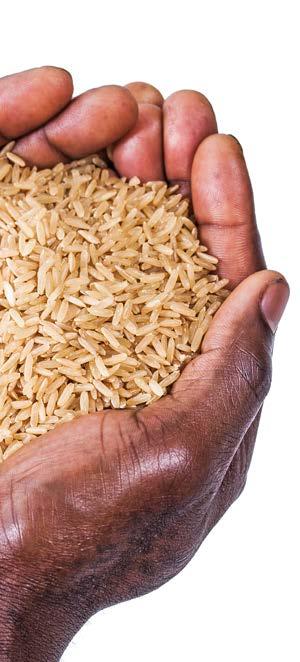
The main challenge of the sector is to establish distribution and export channels for production, as well as to establish agricultural machinery services in the country in order to increase production cover domestic demand and reduce production costs.

Ganadería E l clima y la extensión de tierra disponible convierte a Guinea Ecuatorial en un emplazamiento competitivo para la cría en granjas. Su suelo favorece el cultivo de maíz y soja necesario para la elaboración de piensos. La próxima implementación, a través del Ministerio de Agricultura, Ganadería y Alimentación, de un laboratorio agrícola y servicios veterinarios servirá de soporte a los empresarios del sector.
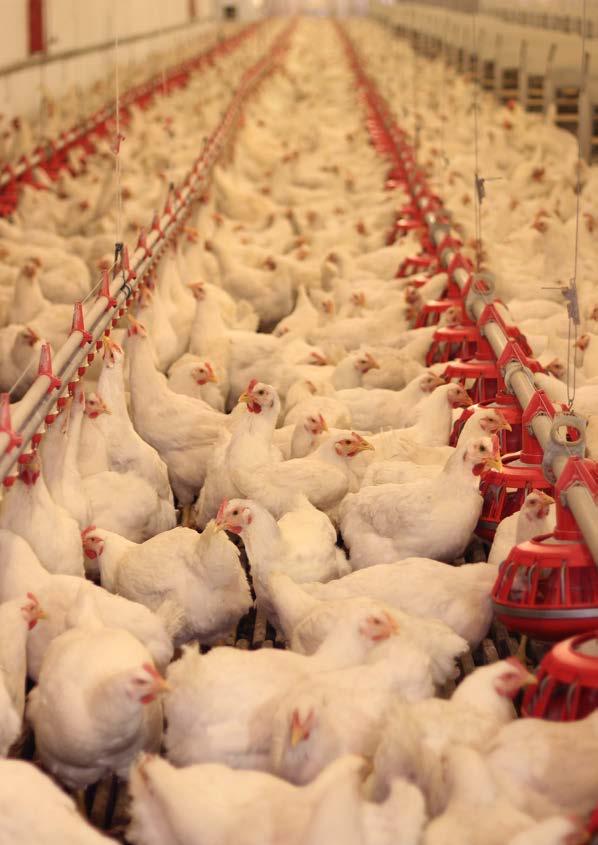
Principales oportunidades del sector ganadero:
• Producción porcina.
• Producción vacuna.
• Matadero.
• Producción de huevos.
• Producción de pollos de engorde.
Livestock T he climate and the available land make Equatorial Guinea a competitive site for ranching. Its soil favours the cultivation of corn and soybeans necessary for the production of feed. The next implementation, through the Ministry of Agriculture, Livestock and Food, an agricultural laboratory and veterinary services will support the business sector.
Main opportunities in the livestock sector:
• Swine production.
• Vaccine production.
• Slaughterhouse.
• Egg production.
• Production of broilers.
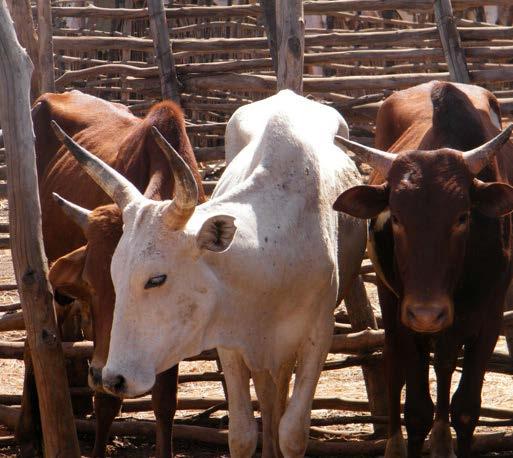
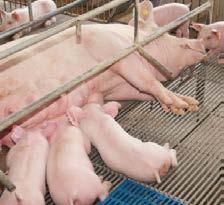
Pesca G uinea Ecuatorial tiene una Zona Económica Exclusiva (ZEE) de 314.000 km² que dispone de importantes recursos pesqueros sin explotar o explotados de forma marginal y rudimentaria. Para fomentar una explotación sostenible del sector en los últimos 2 años se ha elaborado una Ley Reguladora de la Actividad Pesquera y Acuícola, en conformidad con la normativa internacional. Se pretende someter al Gobierno la propuesta de adhesión de Guinea Ecuatorial a la COREP (Organización subregional del Golfo de Guinea sobre la pesca) e igualmente se ha elaborado un Plan para la reactivación del Acuerdo de pesca entre la Unión Europea y la República de Guinea Ecuatorial.


El Plan Estratégico del Sector Pesquero de Guinea Ecuatorial (PEPGE) detalla los sectores pesqueros a desarrollar desde la pesca artesanal, semi-industrial, industrial y deportiva. Además, desde el Ministerio de Pesca se ha procedido a la instalación del Sistema Satelital de control y monitoreo de barcos de pesca VMS (Vessel Monitoring Sistem). Guinea Ecuatorial ha adoptado un Plan Nacional de Lucha contra la Pesca Ilegal No Declarada y No reglamentada (INDNR) y ha ratificado dos convenios internacionales en materia de lucha contra la pesca ilegal; el primero relacionado con el Estado Rector de Puerto de la FAO y el segundo, sobre especies transzonales y especies de peces altamente migratorias.
Principales oportunidades en el sector pesquero:
• Proyecto de transformación de atún en Annobón. • Proyecto de infraestructuras y flota pesquera. • Proyecto de cría y engorde de la tilapia en Mongomo. • Proyecto de cría y engorde del barbo en Ebibeyin. • Proyecto de cría y engorde de la carpa en Evinayong. • Proyecto de cría y engorde del langostino en Rio Campo. • Proyecto de implantación de una base industrial de pesca en el distrito de Kogo.
The Strategic Plan for the Fisheries Sector of Equatorial Guinea (PEPGE) details the fishing sectors to develop from artisanal, semi-industrial, industrial and sports fishing. In addition, the Vessel Monitoring System (VMS) has been installed by the Ministry of Fisheries. Equatorial Guinea has adopted a National Plan to Combat Illegal Unreported and Unregulated Fishing (IUU) and ratified two international conventions on combating illegal fishing; the first related to the FAO Port State and the second, on straddling species and highly migratory fish species.
Main opportunities in the fishing sector:
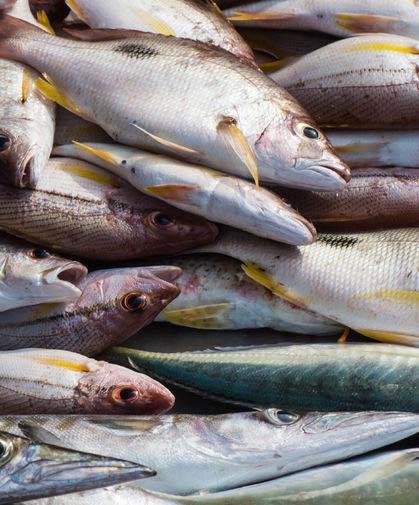
• Tuna processing project in Annobón. • Infrastructure project and fishing fleet. • Tilapia breeding and fattening project in Mongomo. • Ebibeyin barbel breeding and fattening project. • Evinayong carp breeding and fattening project. • Shrimp farming and fattening project in Rio Campo. • Project to establish an industrial fishing base in Kogo district.
Fisheries
Equatorial Guinea has an Exclusive Economic Zone (EEZ) of 314,000 km² which has significant untapped or marginally rudimentary exploited fish resources. In order to promote a sustainable exploitation of the sector in the last 2 years, a Law Regulating the Fishing and Aquaculture Activity has been drawn up, in accordance with international regulations. It is intended to submit to the Government the proposal for Equatorial Guinea’s accession to the COREP (Sub-regional Gulf of Guinea Organization on fisheries) and a Plan for the reactivation of the Fisheries Agreement between the European Union and the Republic of Equatorial Guinea.

Minería E n la última década numerosos estudios han mostrado la evidencia significativa de oro, diamantes, bauxita, estaño, tungsteno y depósitos de coltán en todo el país. En este sector los esfuerzos se centran en la mejora del clima de negocios para las empresas mineras e inversionistas, mediante el desarrollo de una regulación simplificada e integral para la industria de la extracción minera y procesamiento de minerales, además de la implementación de los principios de transparencia internacionales para el sector. Desde el Ministerio de Minas e Hidrocarburos se ha elaborado un reglamento ministerial sobre prospección, exploración y explotación minera para complementar la Ley de Minería 9/2006.
Existe una explotación artesanal de oro fluvial en la zona de Niefang. Entre las principales oportunidades del sector encontramos:
• Mecanización de la explotación de oro fluvial en la zona de Niefang. • Proyectos de prospección de oro, bauxita, coltán, diamante, hierro y caolinita.


Petroquímica
En este momento, Guinea Ecuatorial apuesta por desarrollar todo su potencial en el sector de la petroquímica, trabajando con el sector privado para crear una industria nacional altamente desarrollada y verticalmente integrada.
Principales oportunidades del sector petroquímico:
• Refinación y reciclaje de residuos industriales. • Industria de la pintura. • Industria del asfalto. • Recauchutado de neumáticos. • Reciclaje de plásticos.

Mining I n the last decade numerous studies have shown significant evidence of gold, diamonds, bauxite, tin, tungsten and coltan deposits throughout the country. In this sector, efforts are focused on improving the business climate for mining companies and investors through the development of a simplified and comprehensive regulation for the mining and mineral processing industry, in addition to the implementation of the principles of transparency for the sector. From the Ministry of Mining and Hydrocarbons, a ministerial regulation on survey, exploration and mining has been elaborated to complement Mining Law No 9/2006.
There is an artisanal exploitation of river gold in the Niefang area. Among the main opportunities of the sector we find:
• Mechanisation of the exploitation of river gold in the Niefang area. • Projects to prospect for gold, bauxite, coltan, diamond, iron and kaolinite.
Petrochemistry
At the moment, Equatorial Guinea is committed to developing its full potential in the petrochemical sector, working with the private sector to create a highly developed and vertically integrated national industry.
Main opportunities in the petrochemical sector:
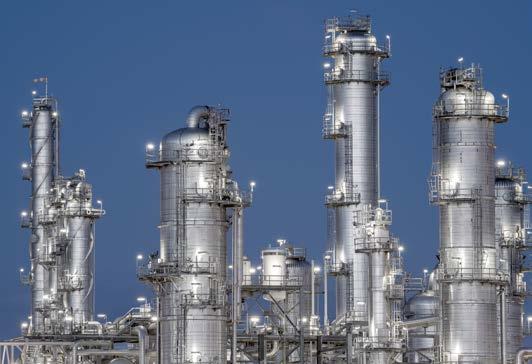
• Refining and recycling of industrial waste. • Paint industry. • Asphalt industry. • Retreading of tires. • Recycling of plastics.
La fuerte inversión en infraestructuras de calidad promovidas por la primera fase del “Plan de Nacional de Desarrollo Económico y Social 2020” ha dotado a Guinea Ecuatorial de una moderna red para el crecimiento de este sector. El puerto principal del país situado en la capital, Malabo, ha sido remodelado para ampliar su capacidad pudiendo albergar buques de hasta 16 metros de calado. Transportes
Los aeropuertos de las principales ciudades, Malabo y Bata, también han sido remodelados con la construcción de modernas terminales. Además, se han construido tres nuevos aeropuertos en Annobón, Mongomeyen y Corisco con el objetivo de mejorar las comunicaciones y el transporte con el resto de ciudades. Se ha construido una moderna red de carreteras y autopistas en todo el territorio nacional. Esta red además de acortar el tiempo de trayectos, ha permitido a las zonas rurales poco accesibles salir del aislamiento que experimentaban.
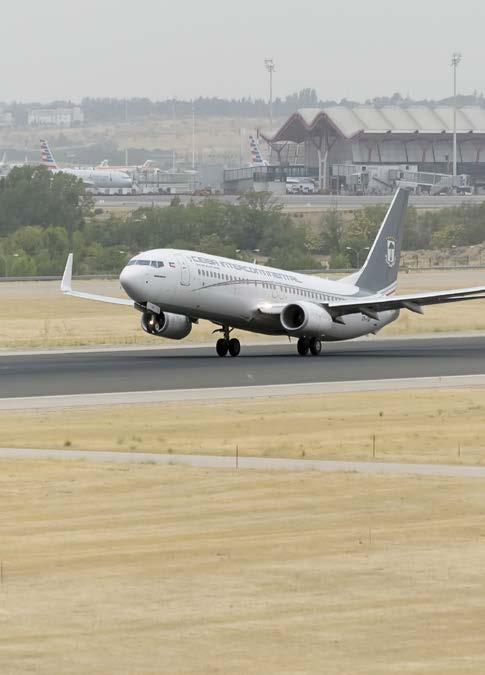
Principales oportunidades del sector de transportes.
1. Aerolíneas comerciales. 2. Transporte de mercancías. 3. Red de transporte interurbano. 4. Compañías de Taxi.
The strong investment in quality infrastructures promoted by the first phase of the “National Plan for Economic and Social Development 2020” has given Equatorial Guinea a modern network for the growth of this sector. The main port of the country located in the capital, Malabo, has been remodelled to expand its capacity and can accommodate ships up to 16 meters draft. Transports
The airports of the main cities, Malabo and Bata, have also been remodelled with the construction of modern terminals. In addition, three new airports have been built in Annobon, Mongomeyen and Corisco with the aim of improving communications and transportation with other cities.
A modern network of roads and motorways has been built throughout the country. This network, in addition to shortening the travel time, has allowed the rural areas that are not accessible to come from the isolation they used to experience.
Main opportunities in the transport sector.
1. Commercial airlines. 2. Goods Transportation. 3. Inter-urban transport network. 4. Taxi Companies.
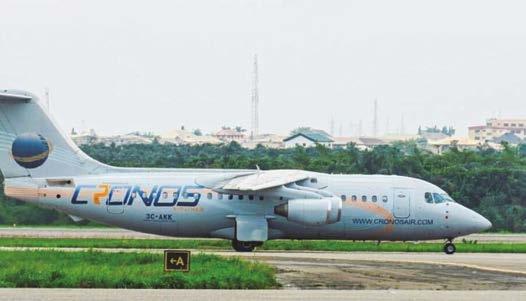

Turismo C on una vasta extensión de paisajes vírgenes terrestres y marinos, una infraestructura básica desarrollada y un clima atractivo, Guinea Ecuatorial podría convertirse en uno de los principales destinos de ecoturismo en África. En los últimos años se ha trabajado en el desarrollo de la infraestructura hotelera y se ha priorizado en la eliminación de obstáculos para el desarrollo de este sector. Desde la presentación del Plan Nacional de Turismo se han presentado diferentes propuestas de ley que ayuden al fomento del sector, entre estas podemos encontrar:
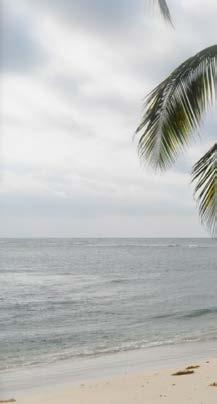
• Propuesta de Ley de Visado Turístico. • Propuesta de Ley General de Clasificación y Calidad de Establecimientos Hoteleros en Guinea Ecuatorial. • Propuesta de Ley de Regulación del Guía Turístico. • Propuesta de Ley de Regulación de Agencias de Viajes. • Propuesta de Ley de Protección al Turista.
Además, de las oportunidades que ofrece como principal destino de ecoturismo para el desarrollo de actividades turísticas tropicales, Guinea Ecuatorial también tiene un legado histórico resultado de la presencia española en el país que puede situarle como destino de turismo cultural. Las islas de Bioko, Corisco y Annobón son los principales destinos del turismo de costa. Bioko, dispone de reservas naturales donde se puede ver en libertad tortugas marinas o especies únicas de primates en zonas como Ureka y el pico Basilé. En el continente el parque nacional de los Altos de Nsork y el parque nacional de Monte Alen, entre otros completan la oferta de ecoturismo.
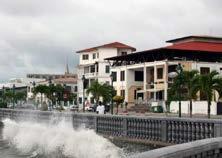
La posibilidad para desarrollar un turismo de alto valor, se puede vislumbrar en el complejo de lujo Sofitel Sipopo situado a 20 minutos de la capital, Malabo. Sipopo y Djibloho disponen de salas de conferencias con capacidad para albergar eventos de carácter internacional, capacidad probada tras la celebración de eventos como la Unión Africana en 2011, la Copa Africana de Naciones en 2012 y 2015 o la Cumbre África- Mundo Árabe en 2016.


Tourism W ith a vast expanse of unspoilt land and marine landscapes, a developed basic infrastructure and attractive climate, Equatorial Guinea could become one of Africa's top ecotourism destinations. In recent years we have worked on the development of hotel infrastructure and prioritised the elimination of obstacles to the development of this sector. Since the presentation of the Tourism National Plan, different proposals have been presented to help promote the sector, among these we can find:
• Proposal of Tourist Visa Law. • Proposed General Law on Classification and Quality of Hotel Establishments in Equatorial Guinea. • Proposed Law of Regulation of the Tourist Guide. • Proposed Law on the Regulation of Travel Agencies. • Proposed Law of Protection to the Tourist. Equatorial Guinea also has a historical legacy as a result of the Spanish presence in the country that can be used as a destination for cultural tourism. The islands of Bioko, Corisco and Annobón are the main destinations for coastal tourism. Bioko, has natural reserves where you can see marine turtles or unique species of primates in areas like Ureka and Basilé Peak. In the continent, the national park of the Altos de Nsork and the national park of Monte Alen among others, complete the offer of ecotourism.
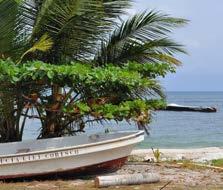
The possibility to develop high value tourism can be glimpsed in the luxury complex Sofitel Sipopo, located to 20 minutes of the capital, Malabo. Sipopo and Djibloho have conference rooms with capacity for hosting international events, proven capacity following events such as the African Union in 2011, the African Cup of Nations in 2012 and 2015 or the Africa-Arab World Summit in 2016.
El sistema legal de Guinea Ecuatorial está compuesto por un abanico de leyes tendentes a mejorar y garantizar la financiación y la fluidez de capital en el territorio nacional. En los últimos años el Gobierno de Guinea Ecuatorial ha realizado modificaciones en su legislación con el propósito de crear un entorno atractivo para la inversión, así como propiciar el aumento de oportunidades de empleo y la participación nacional en la producción y exportación de bienes y servicios. Todas las leyes promulgadas son publicadas en el Boletín Oficial del Estado (B.O.E) y están a disposición de quien las solicite en la Dirección General de B.O.E.

Guinea Ecuatorial es miembro de la Organización Mundial de la Propiedad Intelectual (OMPI) y del Organismo Multilateral de Garantía de Inversiones (OMGI), además ha ratificado tratados Bilaterales de Inversión con países como China, Marruecos, Sudáfrica, Etiopía o Portugal entre otros.
Equatorial Guinea’s legal system is made up of a range of laws aimed at improving and guaranteeing the financing and flow of capital in the national territory. In recent years, the Government of Equatorial Guinea has made changes to its legislation in order to create an attractive investment environment, as well as to promote increased employment opportunities and national participation in the production and export of goods and services. All the enacted laws are published in the Official State Gazette (B.O.E) and are available to anyone requesting them in the B.O.E. General Directorate.

Equatorial Guinea is a member of the World Intellectual Property Organization (WIPO) and the Multilateral Investment Guarantee Agency (MIGA). It has also ratified Bilateral Investment Treaties with countries such as China, Morocco, South Africa, Ethiopia and Portugal among others.
La inversión extranjera, a excepción de las actividades mineras y de hidrocarburos, está sujeta a la Ley 7/1992 de fecha 30 de Abril sobre el Régimen de Inversiones. El sector minero se rige exclusivamente por la Ley de Minería 9/2006.
El Decreto 127/2004 de fecha 14 de Septiembre, por el que se dictan normas complementarias que potencien la Participación Nacional en la Actividad Empresarial, establece normas adicionales al régimen de inversión, en particular, la obligación por parte de inversores extranjeros de contar al menos con un socio de nacionalidad ecuatoguineana que ostente una participación mínima en el capital de la empresa del 35%. Según la última actualización del código de inversiones, mediante el decreto 72/2018, las empresas extranjeras de los sectores No petrolero, con interés en invertir en Guinea Ecuatorial no tienen la obligación de requerir la participación de un socio ecuatoguineano.
Otras leyes sectoriales de interés para el inversor son:
• La Ley núm. 6/1990 de fecha 29 Octubre, sobre Régimen Especial de Inversiones de Pequeñas y Medianas Empresas. • La Ley sobre Régimen de Instalación, Ampliación y traslado de Industrias. • Ley Reguladora del Sistema Tributario. Ventajas fiscales por las inversiones
• Por la creación de nuevos empleos. Reducción de la base imponible del Impuesto sobre la Renta equivalente al 50% de los salarios pagados durante 18 años. • Por la formación del personal nacional. Reducción de la base imponible del Impuesto sobre la Renta equivalente al 200% del coste no salarial imputado a la capacitación y durante 18 años. • Por el fomento de las exportaciones no tradicionales. Obtención de crédito valido para el pago de cualquier obligación fiscal y/o aduanero durante 18 años, equivalente al 15% de las sumas recibidas en un banco comercial a cuenta de la empresa por sus exportaciones no tradicionales. • Por el desarrollo regional o local de la zona geográfica donde se desempeñe la actividad empresarial. Las empresas que ejecuten proyectos en áreas alejadas de grandes centros urbanos se beneficiarán de la amortización total de los gastos de infraestructuras pagados y aplicables al año impositivo imputable al gasto. También se beneficiarán de la exención total de pago de toda clase de obligación impositiva a excepción del IRPF, IVA, Gravámenes Aduaneros y otros aplicables a su actividad. • Por la participación de inversores o socios de nacionalidad ecuatoguineana en el capital de la empresa. Reducción de la base imponible de IRPF de la cantidad que resulte al aplicar el 1% sobre el exceso del 50% de la participación de los nacionales en el capital social. Foreign investment, with the exception of mining and hydrocarbon activities, is subject to Law 7/1992 dated 30th April on the Investment Regime. The mining sector is governed exclusively by Mining Law 9/2006.
Decree 127/2004 dated 14th September which enacted supplementary rules that enhance the National participation in Business Activity, establishes additional rules to the investment regime in particular, the obligation on foreign investors to count at least with a partner of Equatoguinean nationality that holds a minimum of 35% participation in the capital of the company. This rule is not longer applicable to all sectors due to the latest update of the investment code, by decree 72/2018, foreign companies from non-oil sectors, which have interest to invest in Equatorial Guinea are not on the obligation to acquire the participation of an Equatoguinean partner.
Other sectoral laws of interest to the investor are:
• Act No. 6/1990 dated 29th October, on the Special Regime for small and medium-sized enterprise investments. • The Law on installation, expansion and transfer of industries regime. • Law Regulating the Tax System.
Investments fiscal advantages
• For the creation of new jobs. Reduction of the income tax base equivalent to 50% of wages paid over 18 years. • For national staff training. Reduction of the income tax base equivalent to 200% of the non-salary cost imputed to capacity-building and for 18 years. • For the promotion of non-traditional exports. Securing valid credit for the payment of any tax and/or customs obligation for 18 years, equivalent to 15% of the sums received in a commercial bank on account of the company for its non-traditional exports. • For regional or local development of the geographical area where the business activity is carried out.Companies that carry out projects in areas away from large urban centres will benefit from the full amortization of infrastructure expenses paid and applicable to the tax year attributable to expenditure. They will also benefit from the total exemption from payment of all kinds of tax obligations, except for personal income tax, VAT, customs levies and others applicable to their activity. • For the participation of investors or partners of Equatoguinean nationality in the capital of the company. Reduction of the income tax base of the amount that results when applying 1% on the excess of 50% of national’s participation in the share capital.


Equity flow remittances
Law 7/1992 on the Investment Regime recognises the right to the equity flow remittances. The COBAC regulation states in article 55 that non-residents transfers of capital abroad from the CEMAC area in the form of profits, dividends, interests, royalties, etc., are free when the basic operation has been authorised or it is not subject to authorisation.
Types of companies

According to the code OHADA in Equatorial Guinea these are the different types of companies accepted:
• General Association. The one in which all the partners are merchants and respond in a manner and in solidarity to the debts. The association is designated by a name that must be preceded or followed by the word “association”.
• Limited society. In which one or more members called “general partners” will be responsible for the social debts, with one or more partners responsible for the debts within the limits of their contributions called “limited partners” and whose capital is divided into shares.
• Limited Liability Company. The one in which each partner will be responsible only of the amount proportional to their contributions and whose rights are represented by shares. The share capital must be at least 1,000,000 XAF, divided in equal parts and with a nominal value of not less than 5,000 XAF.
• Corporation. The one in which the shareholders are only responsible for debts proportional to the amount of contribution and whose rights are represented by shares. The minimum share capital for this type of company is set at 10,000,000 XAF divided into shares with a par value of not less than 10,000 XAF.
• Joint Venture. The one in which the partners by signing a contract reach a common agreement to contribute resources to a common business for a limited time, without this implying loss of individuality as a legal person or company.
Creación de empresas
La Ley número 2/2015, de fecha 28 de Mayo del Régimen Jurídico de la Administración General del Estado, en su disposición transitoria única determina que en tanto no haya sido constituida la ventanilla única para la constitución de sociedades mercantiles distintas a las referidas en el artículo17, párrafo 9, inciso a, de dicha ley (cítense aquellas cuyo objeto social sea la explotación de recursos y servicios reservados al sector público), será suficiente la inscripción en el reglamento mercantil de la escritura notarial de constitución de la sociedad, la obtención del número de NIF y el alta en el departamento de afección, nacionalizando así los trámites necesarios. Mediante el decreto N. 67/2017 de fecha 12 de septiembre, el Gobierno creó la Ventanilla Única Empresarial cuyo objetivo es asistir a los emprendedores y reducir el plazo de establecimiento para nuevas empresas. Una vez finalizados todos los procedimientos para su puesta en funcionamiento, la Ventanilla Única podrá ser operativa próximamente.

Propiedad industrial
Guinea Ecuatorial es miembro de la Organización Africana de la Propiedad Intelectual (OAPI). Para el registro de una marca, patente o diseño se deberá presentar la siguiente documentación:
• Cumplimentación del formulario M 301.
• Documento que acredite el pago de las tasas e impuestos correspondientes.
• Un poder legal, si el demandante desea hacerse representar por un agente.

• La reproducción de la marca tal y como exige el formulario M 301.
• En su caso, un documento de prioridad de registro.
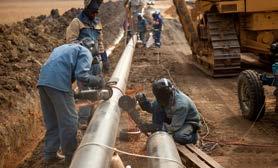
Tras la adhesión de la OAPI al protocolo de Madrid en Marzo de 2015, se ofrece a los 15 países miembros un acceso más rápido y económico a la protección de marca internacional.
Companies creation
Law No. 2/2015, dated 28th May of the Legal Regime of the General State Administration, in its sole transitional provision determines that, until the single window for the incorporation of mercantile companies other than those referred to in Article 17, paragraph 9, subparagraph a, of the said law (including those whose corporate purpose is the exploitation of resources and services reserved to the public sector), it will suffice to include in the mercantile regulations of the company’s notarised deed, the NIF number and discharge in the department, thus nationalizing the necessary procedures. Through decree N. 67/2017 dated September 12, the Government created the Single Business Window, which aims to assist entrepreneurs and reduce the establishment period for new companies. Once all the procedures for its start-up have been completed, the Single Window may be operational soon.

Industrial property
Equatorial Guinea is a member of the African Intellectual Property Organization (OAPI). For the registration of a trademark, patent or design the following documentation must be submitted:
• Completion of Form M 301.
• Document proving the payment of the corresponding taxes and fees.
• A power of attorney, if the plaintiff wishes to be represented by an agent.
• Reproduction of the mark as required by Form M 301.
• If applicable, a registration priority document.

Following OAPI’s adhesion to the Madrid Protocol in March 2015, international brand protection access is offered faster and cheaper to the 15 member countries.
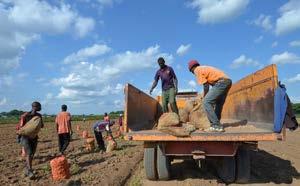

Desde su creación en septiembre de 2014 HOLDING G.E. se ha encargado de crear una estructura sólida que garantice la ejecución de proyectos de Co-Inversión rentables para Guinea Ecuatorial. En la actualidad está en fase de desarrollo de sus primeros proyectos de Co-Inversión en los sectores de agricultura, ganadería y pesca que garanticen la seguridad alimentaria con respecto a estos productos (plataforma hortícola, granja avícola, granja porcina, piscicultura).
Cualquier inversor nacional o extranjero puede asociarse con HOLDING Guinea Ecuatorial para la implementación de un proyecto, presentando el proyecto integro a HOLDING Guinea Ecuatorial. Tras el estudio de la rentabilidad y viabilidad del proyecto, HOLDING G.E. determinará su participación como socio del mismo. Al cofinanciar un proyecto HOLDING G.E. se convierte en el socio minoritario de una nueva sociedad nacional con un porcentaje de participación de entre el 49%-1%. Los inversores, sean extranjeros o nacionales, deben aportar el porcentaje de financiación que les convierta en socios mayoritarios. La dirección y gestión de la nueva sociedad corresponderá al socio mayoritario.
Para beneficiarse de la Co-financiación los proyectos presentados deben reunir los siguientes requisitos:
• El proyecto debe crear una actividad productiva en el país, que genere empleo para la población activa en los sectores estratégicos para la diversificación económica (la agricultura, la ganadería, la pesca, la minería y los servicios en general).
• El proyecto debe ser rentable.
• El proyecto debe prever la formación del capital humano para la continuidad de la actividad productiva, en el supuesto caso de que los socios privados extranjeros se retiren.
• El proyecto debe prever la transmisión del saber hacer a los nacionales.
Since its creation in September 2014 HOLDING G.E. has been responsible for creating a solid structure to ensure the implementation of cost-effective co-investment projects for Equatorial Guinea. It is currently in the process of developing their first co-investment projects in the agriculture, livestock and fisheries sectors that guarantee food security with respect to these products (horticultural platform, poultry farm, pig farm, fish farming).

Any national or foreign investor may associate with HOLDING Equatorial Guinea for the implementation of a project, presenting the whole project to HOLDING Equatorial Guinea. After studying the profitability and viability of the project, HOLDING G.E. will determine its participation as partner of it. By co-financing a project, HOLDING G.E. becomes the minority partner of a new national company with a participation rate of between 49% -1%. Investors, whether foreign or national, must contribute the percentage of funding that makes them the majority partners. The direction and management of the new company will correspond to the main shareholder.
To benefit from the co-financing, the projects presented must meet the following requirements:
• The project must create a productive activity in the country that generates employment for the active population in the strategic sectors for economic diversification (agriculture, livestock, fisheries, mining and services in general).
• The project must be profitable.
• The project must foresee the formation of human capital for the continuity of productive activity in the event that the foreign private partners withdraw.
• The project must provide the transmission of knowhow to nationals.
Si un inversor no dispone de proyecto propio, Holding Guinea Ecuatorial dispone en su cartera de varios proyectos de Co-Inversión. Son proyectos en los que se ha confirmado la participación de HOLDING Guinea Ecuatorial, pero todavía requieren de uno o varios accionistas para comenzar su ejecución. Los proyectos disponibles en 2018 son:
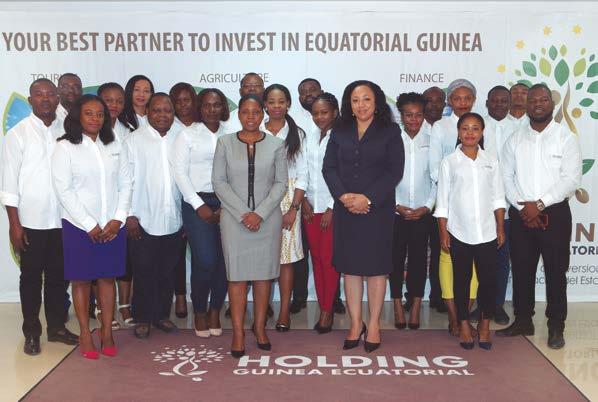
• Construcción de granja avícola para la producción de pollos y huevos.
• Construcción de granja ganadera y base de producción de pienso.
• Transformación de yuca en harina.
• Producción de cacao y fábrica de chocolate.
• Cultivo y producción de aceite refinado de palma.
• Cultivo e industrialización del arroz. • Producción hortícola.
• Agro-industrial integrado.
• Piscicultura.
• Producción de piezas de mobiliario plástico para equipamiento de los edificios escolares.
• Construcción de centro de tratamiento y reciclaje de los residuos petroquímicos.
Puede obtener más información sobre los proyectos de Co-Inversión disponibles en el siguiente enlace:
https://www.holdingequatorialguinea.com/español/planes-de-acción-e-informes/proyectos/
If an investor does not have its own project, Holding Guinea Equatorial has in its portfolio several co-investment projects. These are projects in which the participation of HOLDING Equatorial Guinea has been confirmed, but they still require one or more shareholders to begin execution. The projects available in 2018 are:
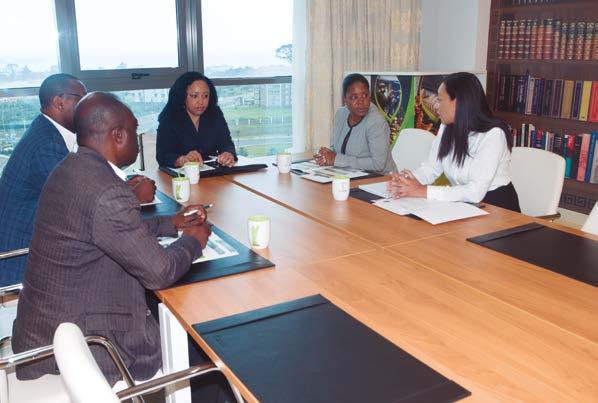
• Construction of poultry farm for the production of chickens and eggs.
• Construction of livestock farm and feed production base.
• Transformation of cassava into flour.
• Production of cocoa and chocolate factory.
• Cultivation and production of refined palm oil.
• Cultivation and industrialization of rice. • Horticultural production.
• Integrated agro-industrial.
• Pisciculture.
• Production of pieces of plastic furniture for the equipment of school buildings.
• Construction of a treatment and recycling centre for petrochemical waste.
You can get more information on Co-Investment projects available at the following link:
https://www.holdingequatorialguinea.com/english/action-plans-reports/co-investment-projects/
Visados
Tanto los visados con propósitos turísticos como los de negocios son emitidos por las embajadas y misiones diplomáticas de Guinea Ecuatorial en el exterior. Entre los diferentes documentos a presentar para la obtención de visado se debe contar con una carta de invitación emitida por un ciudadano o por una entidad de Guinea Ecuatorial. A la llegada a Guinea Ecuatorial deberá entregar rellenada la tarjeta de llegada al realizar el paso por el control de pasaportes, así como la cartilla de vacunación contra el cólera, la fiebre amarilla y la viruela en caso de ser requerido por las autoridades sanitarias. Los visados turísticos tienen validez para una estancia de 30 días, si se prevé alargar la estancia se debe ampliar la validez del visado por un nuevo período máximo de 30 días en el Ministerio de Seguridad Nacional.

Permiso de trabajo
Para la contratación de personal expatriado, la empresa contratante debe solicitar la Autorización de Reclutamiento en el Ministerio de Trabajo y Seguridad Social, debiendo aportar fotocopia del pasaporte, fotos y copia de la titulación del trabajador a contratar. Esta Autorización de Reclutamiento debe adjuntarse para la solicitud del permiso de residencia.
Permiso de residencia
Los expatriados que deseen trabajar en Guinea Ecuatorial precisarán legalizar su situación en el país mediante la obtención de un permiso de residencia. Este permiso debe solicitarse en el Ministerio de Seguridad Nacional adjuntando: instancia de solicitud, fotografías recientes, copia de la entrada legal en el país, autorización de reclutamiento, contrato de trabajo, atestación y extracto bancario, solvencia tributaria y un certificado médico expedido exclusivamente por la Clínica Guadalupe o el Hospital La Paz. El permiso de residencia deberá ser renovado anualmente.
Permiso de conducir
Para conducir en Guinea Ecuatorial se precisa un permiso de conducir local. Los permisos de conducir internacionales deben ser convalidados en la Dirección General de Tráfico en el Ministerio de Interior y Corporaciones Locales.
Visas
Both tourism and business purposes visas are issued by embassies and diplomatic missions of Equatorial Guinea abroad. Among the different documents to be presented for obtaining a visa, you must have a letter of invitation issued by a citizen or an Equatorial Guinea entity. Upon arrival in Equatorial Guinea, the arrival card must be filled out with the passport control, as well as the vaccination card against cholera, yellow fever and smallpox if required by the health authorities. Tourist visas are valid for a stay of 30 days, if it is expected to extend the stay, the validity of the visa must be extended for a new maximum period of 30 days at the Ministry of National Security.
Work permit

For the recruitment of expatriate personnel, the contracting company must request the Recruitment Authorisation from the Ministry of Labour and Social Security, and must provide a photocopy of the passport, photos and a copy of the qualifications of the worker to be hired. This Recruitment Authorisation must be attached for the application of the residence permit.
Permission of residence
Expatriates wishing to work in Equatorial Guinea will need to legalise their situation in the country by obtaining a residence permit. This permit must be requested at the Ministry of National Security, enclosing: application form, recent photographs, copy of the legal entry in the country, authorisation of recruitment, work contract, certificate and bank statement, tax credit and a medical certificate issued exclusively by The Guadalupe Clinic or the La Paz Hospital. The residence permit must be annually renewed.
Driving license

A driver’s license is required for driving in Equatorial Guinea. International driver’s licenses must be validated at the General Directorate of Traffic at the Ministry of Interior and Local Corporations.
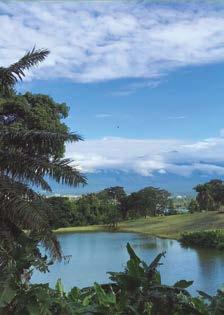
Alojamiento y alquiler de inmuebles
El coste medio de alojamiento en hoteles se sitúa entre 80.000 y 120.000 XAF por noche. El precio del alquiler de viviendas en Malabo (2 habitaciones) se sitúa entre 250.000 y 500.000 XAF mensuales en el centro de la ciudad. En la periferia el precio se sitúa entre los 150.000 y 300.000 XAF.
Días festivos
El calendario laboral prevé un número total de festivos anuales de 11 días:
1 de Enero. Año Nuevo. 1 de Mayo. Día Internacional del Trabajo. 5 de Junio. Cumpleaños del Presidente. 3 de Agosto. Conmemoración del Golpe de Libertad. 15 de Agosto. Día de la Constitución. 12 de Octubre. Día de la Independencia. 8 de Diciembre. Día de la Inmaculada Concepción. 25 de Diciembre. Día de Navidad.
También serán festivos con fecha no fija en el calendario el Viernes Santo y el día de Corpus Christi. Cada municipio reservará un día festivo que coincidirá con la festividad del patrón del municipio. En la capital, Malabo, se celebra el 17 de Noviembre, día de Santa Isabel.
Accommodation and rental of properties
The average cost of hotel accommodation is between 80,000 and 120,000 XAF per night. The price of the rental of houses in Malabo (2 rooms) is between 250,000 and 500,000 XAF per month in the city centre. In the periphery the price is between 150,000 and 300,000 XAF.
Holidays
The work calendar foresees a total number of annual holidays of 11 days:
1st January, New Year. 1st May, International work day. 5th June, President’s Birthday. 3rd August, Commemoration of the “Liberty Coup”. 15th August, day of the Constitution. 12th October, Independence Day. 8th December, Immaculate Conception’s Day. 25th December, Christmas day.
Also they will be not fixed holidays in the calendar, Good Friday and the day of Corpus Christi. Each municipality will reserve a festive day that will coincide with the festival of the patron of the municipality. In the capital, Malabo is celebrated on 17th November, the day of Santa Isabel.

Turismo Cultural y su amplia oferta turística Guinea Ecuatorial Descubre
Turismo de Ocio

Ecoturismo


